|
Highlights from the Network
Delaware's Commitment to Health Equity and New Inclusion Policy
 The Wilmington News Journal published an op-ed piece that Eileen Sparling, Ed.M. Project Director, Center for Disability Studies, University of Delaware co-wrote with the Delaware Secretary of Health and Social Services (DHSS) Rita Landgraf, setting health equity for people with disabilities as the next target for the work of the ADA in Delaware. In addition to noting the health disparities experienced by Delawareans with disabilities and pointing to the products of their CDC- funded project - a public health assessment that documented disparities and a Plan to Achieve Health Equity, the op-ed also introduced the new Inclusion Policy that the Secretary signed at Delaware's official celebration in the state capital. The Wilmington News Journal published an op-ed piece that Eileen Sparling, Ed.M. Project Director, Center for Disability Studies, University of Delaware co-wrote with the Delaware Secretary of Health and Social Services (DHSS) Rita Landgraf, setting health equity for people with disabilities as the next target for the work of the ADA in Delaware. In addition to noting the health disparities experienced by Delawareans with disabilities and pointing to the products of their CDC- funded project - a public health assessment that documented disparities and a Plan to Achieve Health Equity, the op-ed also introduced the new Inclusion Policy that the Secretary signed at Delaware's official celebration in the state capital.
The policy will require contractors and grantees to address how their programs will reach, and be accessible, to people with disabilities. It also addresses inclusion in planning committees and councils, program access to DHSS activities, and data collection and reporting of disability status. A two-minute video including the Secretary's announcement of the policy can be found here. To read the op-ed, "Achieving health equity is the state's next goal", please click here.
Friends of NCBDDD Telebriefing on Prevalence of Disability and Disability Type among Adults

The Friends of NCBDDD invite you to mark your calendars for a special telebriefing on the findings from a new Centers for Disease Control and Prevention (CDC) report entitled: "Prevalence of Disability and Disability Type Among Adults - United States, 2013," scheduled for release on Thursday, July 30, 2015 at 1PM EDT. The report examines state-level prevalence of disability and disability type. This report also presents prevalence estimates of disability by select demographic groups. Please join us at 2PM EDT on Thursday to hear a summary of results from the authors and remarks from NCBDDD leadership and the Friends.
Date: Thursday, July 30, 2015
Time: 2:00 PM (EDT)
Call information:
Call in line: (855)-644-0229 Toll Free, Conference ID Code: 7030150
Join Lync Meeting : https://webconf.cdc.gov/gun2/F4516358
For any questions about the call, or to request disability accommodations, please contact Jennifer Meunier at [email protected].
Public Health Budgets Remain Below Pre-Recession Levels, Report Finds
 Public health expenditures on disease prevention and community health initiatives remained well below pre-recession levels in 2013, a report from the Trust for America's Health and the Robert Wood Johnson Foundation finds. Public health expenditures on disease prevention and community health initiatives remained well below pre-recession levels in 2013, a report from the Trust for America's Health and the Robert Wood Johnson Foundation finds.
The tenth edition of the report, Investing in America's Health: A State-by-State Look at Public Health Funding and Key Health Facts 2015 (20 pages, PDF), found that combined federal, state, and local public health spending in 2013 totaled $75.4 billion, or $239 per person - some 10 percent below 2009 spending levels, adjusted for inflation. According to the study, public health budgets declined on a year-over-year basis in twenty-two states and the District of Columbia, fell for two or more years in a row in seventeen states, and declined for three or more years in a row in nine states. The report also found that over the last decade, the budget for the Centers for Disease Control and Prevention declined slightly from a high of $7.07 billion to $6.93 billion, while funding for the CDC's Public Health Emergency Preparedness Cooperative Agreement fell by nearly a third and the Hospital Preparedness Program budget was cut by more than half...click here to read more.
Public Health is for Everyone
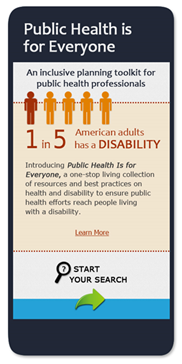 The Public Health is for Everyone movement aims to increase awareness of the health disparities and needs of people with disabilities, and to provide public health professionals with the resources they need to develop inclusive programs. The Public Health is for Everyone Toolkit aims to increase the capacity of public health professionals to create programs that meet the needs of all individuals within a community, including people with disabilities. The Public Health is for Everyone toolkit, located at www.phetoolkit.org provides health professionals with resources including field guides, educational videos, factsheets, checklists, brochures, and other tools. Users can search disability and health related resources by the health needs of your community. To view, download, and share these resources, please visit, www.phetoolkit.org. The health resource topics include nutrition, health care access, physical activity, emergency preparedness, obesity, accessibility, tobacco, and general inclusion issues. You can submit your resources for including people who have a disability in public health efforts for inclusion in the toolkit, so health professionals can learn from and use your strategies. The Public Health is for Everyone movement aims to increase awareness of the health disparities and needs of people with disabilities, and to provide public health professionals with the resources they need to develop inclusive programs. The Public Health is for Everyone Toolkit aims to increase the capacity of public health professionals to create programs that meet the needs of all individuals within a community, including people with disabilities. The Public Health is for Everyone toolkit, located at www.phetoolkit.org provides health professionals with resources including field guides, educational videos, factsheets, checklists, brochures, and other tools. Users can search disability and health related resources by the health needs of your community. To view, download, and share these resources, please visit, www.phetoolkit.org. The health resource topics include nutrition, health care access, physical activity, emergency preparedness, obesity, accessibility, tobacco, and general inclusion issues. You can submit your resources for including people who have a disability in public health efforts for inclusion in the toolkit, so health professionals can learn from and use your strategies.
Do you know health professionals who have resources for including people who have a disability in public health efforts? You can help to further develop Public Health is for Everyone by copying and pasting the above text into your organization's newsletter, so more professionals become aware of the toolkit.
Follow Public Health is for Everyone at @PHis4Everyone and join the inclusion movement! We want to know how you or your organization is including people living with disabilities in public health efforts like nutrition, health care access, physical activity, emergency preparedness, and tobacco. What are the most critical health disparities faced by people with disabilities? How do you/your organization connect with them?
Share your story! It can be a written message, video, selfie or a photo of things you see in your community that relates to including people living with disabilities in public health efforts.
• Email us: Send us your story at [email protected].
• Tweet with us: Be sure to use the hashtags #publichealth and #4all in any tweets!
• Follow us: Follow @PHis4Everyone for updates.
AUCD's New Oral and Dental Health Community of Practice
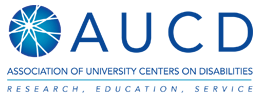
Join AUCD's new Oral and Dental Health Community of Practice. There are two goals for ongoing work in this community of practice:
1. Sharing information/Training promotion (day to day priority)
2. Policy changes related to Medicaid coverage (explore making essential health benefit in exchanges) (long term goal)
This is not a forum to create new work, but to share information and work together. The group will meet every over month and share information in between. The next group call will be August 17, 1pmET. To join, please dial 866-951-1151, code 7307522. Talk with you then!
CDC Releases New Built Environment Assessment Tool
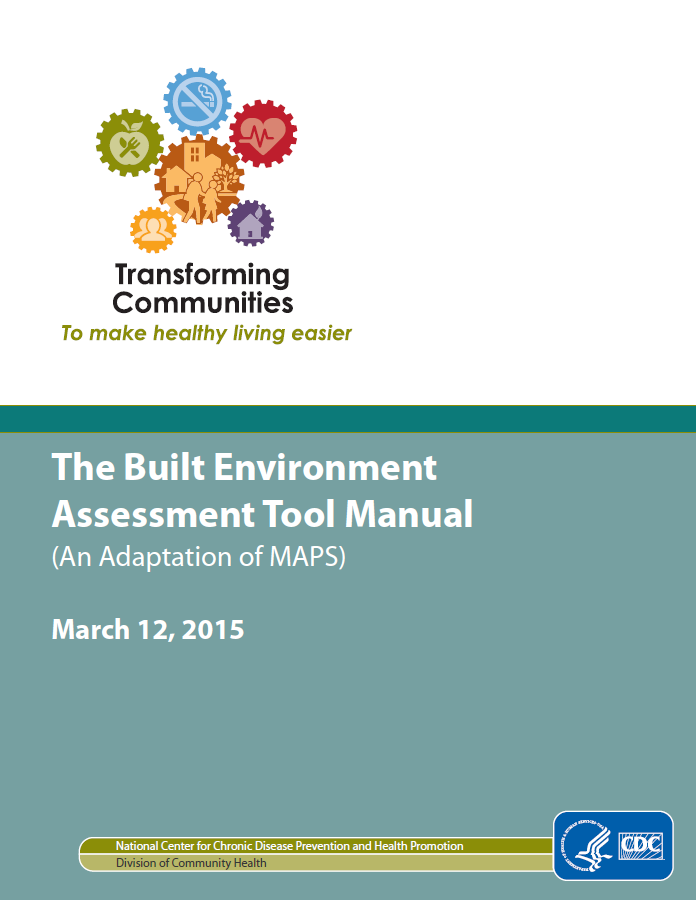 A wide array of tools exists for measuring different features of the built environment, many of them well validated. These existing tools fall into three categories: 1) interview or self-administered questionnaires which primarily measure perceptions, 2) tools that collect archival (existing) data, often using GIS, and 3) systematic observation or audit tools. It is often difficult for local program staff and evaluators to know which features of the built environment are most important to measure on the basis of the health behaviors and outcomes they are trying to affect. It is also difficult to know which tool(s) to choose to most accurately and feasibly assess those features. A wide array of tools exists for measuring different features of the built environment, many of them well validated. These existing tools fall into three categories: 1) interview or self-administered questionnaires which primarily measure perceptions, 2) tools that collect archival (existing) data, often using GIS, and 3) systematic observation or audit tools. It is often difficult for local program staff and evaluators to know which features of the built environment are most important to measure on the basis of the health behaviors and outcomes they are trying to affect. It is also difficult to know which tool(s) to choose to most accurately and feasibly assess those features.
The Built Environment Assessment Tool (BE Tool) (an adaptation of MAPS) was designed to alleviate some of the challenges posed by the significant number of narrowly focused tools aimed at only one activity (walking), one subpopulation (older adults), or one public health area (inactivity). It was created as a collaborative enterprise across multiple areas of public health - health promotion, injury prevention, environmental health, etc. It is a direct systematic observation data collection instrument for measuring the core features and quality of the built environment related to behaviors that affect health, especially behaviors such as walking, biking, and other types of physical activity. There are many aspects of the built environment. The built environment includes the buildings, roads, sidewalks, utilities, homes, transit, fixtures, parks and all other man-made entities that form the physical characteristics of a community. The built environment can impact human health by affecting rates of physical activity, air pollutants such as ozone and particulate matter that can exacerbate asthma and respiratory disease, and emissions of carbon dioxide that contributes to climate change.
The BE Tool was not designed to assess every aspect of the built environment. Rather the tool assesses a core set of features agreed upon by subject matter experts to be most relevant. The core features assessed in the BE Tool include: built environment infrastructure (e.g., road type, curb cuts/ramps, intersections/crosswalks, traffic control, transportation), walkability (e.g. sidewalk/path features, walking safety, aesthetics & amenities), bikeability (e.g., bicycle lane/path features), recreational sites and structures, and the food environment (e.g., access to grocery stores, convenience stores, farmers markets, etc.). Additional questions or modules could be added by users if more detail about an aspect of the built environment, such as the nutrition environment or pedestrian environment, is desired. To access the tool, visit http://www.cdc.gov/nccdphp/dch/built-environment-assessment.
Health and Disability Fellowship at NACCHO

The National Association of County & City Health Officials has an immediate opening for two Health and Disability fellows. This is a paid fellowship to start as soon as possible and run through June 30, 2016. The fellows will work with the health and disability project team to promote disability inclusion, awareness, and education to the public health workforce. Fellows will be involved in a number of activities, including: developing resources, guides, toolkits, and trainings; and developing publications for dissemination, among other activities. The fellowship includes a stipend not to exceed $5,000. The fellow will be housed at either NACCHO headquarters in Washington, D.C., or may work remotely from their graduate school facility.
The CDC Defines Disability Inclusion and Communicates that Public Health is for Everyone!
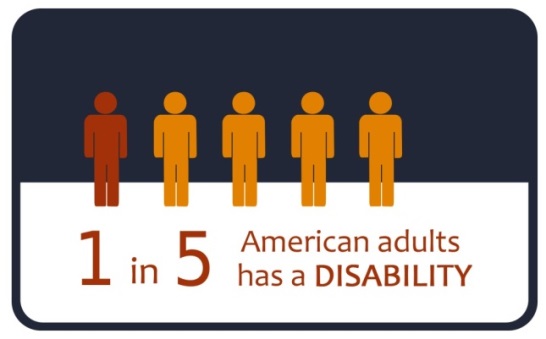 The CDC defines disability inclusion and informs public health professionals that Public Health is for Everyone has the resources they need to develop inclusive programs. The CDC defines disability inclusion and informs public health professionals that Public Health is for Everyone has the resources they need to develop inclusive programs.
What is disability inclusion? Including people with disabilities in everyday activities and encouraging them to have roles similar to their peers who do not have a disability is disability inclusion. This involves more than simply encouraging people; it requires making sure that adequate policies and practices are in effect in a community or organization.
Inclusion should lead to increased participation in socially expected life roles and activities-such as being a student, worker, friend, community member, patient, spouse, partner, or parent.
Socially expected activities may also include engaging in social activities, using public resources such as transportation and libraries, moving about within communities, receiving adequate health care, having relationships, and enjoying other day-to-day activities.
Check out the CDC's Disability and Health home page here and the related pages at the bottom for including people with disabilities in health programs, and use Public Health is for Everyone!
AUCD Celebrates 25th Anniversary of ADA
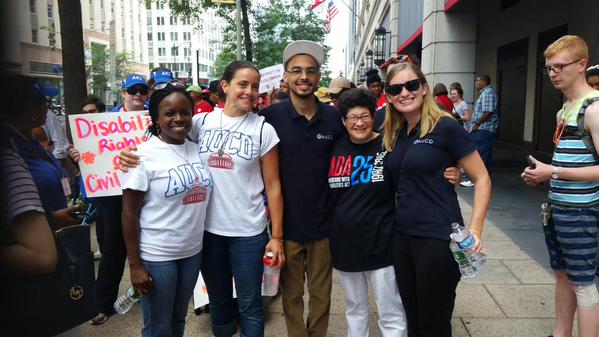 Last week was filled with celebrations of the Americans with Disabilities Act (ADA) silver (25-year) anniversary that occurred on July 26. President Obama and Vice-President Biden hosted several thousand new and returning advocates, including AUCD president Olivia Raynor and several staff, for a festive reception at the White House where the President made remarks in the East Room (see video and fact sheets). The Departments of Labor, Justice, HHS/ACL, and Education also held separate events to celebrate their agencies' accomplishments related to the ADA. At several events, Senators Tom Harkin, Lowell Weicker, and Bob Dole, Rep. Tony Coelho and other federal officials regaled participants with stories about the struggle to pass the landmark civil rights law. The ADA Legacy Tour bus, which rolled across the country all month to raise awareness finally came to a stop in DC on July 26 with a big celebration. Last week was filled with celebrations of the Americans with Disabilities Act (ADA) silver (25-year) anniversary that occurred on July 26. President Obama and Vice-President Biden hosted several thousand new and returning advocates, including AUCD president Olivia Raynor and several staff, for a festive reception at the White House where the President made remarks in the East Room (see video and fact sheets). The Departments of Labor, Justice, HHS/ACL, and Education also held separate events to celebrate their agencies' accomplishments related to the ADA. At several events, Senators Tom Harkin, Lowell Weicker, and Bob Dole, Rep. Tony Coelho and other federal officials regaled participants with stories about the struggle to pass the landmark civil rights law. The ADA Legacy Tour bus, which rolled across the country all month to raise awareness finally came to a stop in DC on July 26 with a big celebration.
AUCD was well represented at these ADA events. AUCD Executive Director Andy Imparato authored an article that was published on the Administration for Community Living (ACL) website and he was quoted in an extensive AP article. Tomorrow, Imparato will be interviewed on the Disability Matters radio show. AUCD also assisted Google.org with its ADA campaign. Google.org created 9 portraits of selected disability movement heroes (including LEND fellow, Tia Nelis) and posted them on stairs at prominent DC locations (see portraits and video). See more about these events and stories, including an interview with Olivia Raynor on AUCD's website and check out the Twitter.com feed under #ADA25.
CDC Releases New Community Health Status Indicators 2015 Web Application

CDC's Community Health Status Indicators (CHSI) 2015 is an interactive web application that produces health profiles for all 3,143 counties in the United States. Each profile includes key indicators of health outcomes, which describe the population health status of a county and factors that have the potential to influence health outcomes, such as health care access and quality, health behaviors, social factors (economic and social conditions that may directly or indirectly influence the health of people and communities) and the physical environment (the natural environment (air, water, and soil) and the built environment (safe and affordable housing, transportation, access to nutritious and affordable food.) The social factors and the physical environment are especially important because they represent the conditions in which people are born, live, work, and play. Key features include:
- Summary Comparison Report - an "at a glance" summary of how a county compares with peer counties on the full set of Primary Indicator.
- Indicator Description -info describing the significance of the indicator, source/years of data, methodology for creation, and any limitations.
- Indicator Downloads - indicator values for each group of peer counties can be downloaded for further examination and analysis.
- Populations - allows users to compare an indicator value for the entire population of a county with sub-populations defined by sex, age groups, and race/ethnicity, where data are available. This feature can be used to assist with identifying potential health disparities.
- Census Tract Maps -identify vulnerable populations and potential health disparities by examining the geographic distribution of select social factor indicators within a county (by census tract).
- Associated Indicators - these are indicators that are related to the primary indicator and may provide additional valuable information. For example, the primary indicator for educational attainment is on-time high school graduation rate. Associated Indicators include percent of adults without a high school diploma and percent of adults with an associate level degree or higher.
|


